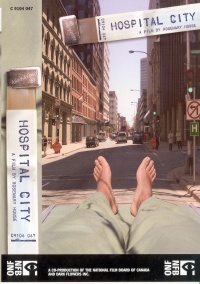| ________________
CM . . .
. Volume XI Number 21 . . . .June 24, 2005
excerpt:
Despite the over-representation of doctors on TV medical dramas, they are not solely responsible for life and death within the busy corridors of Canada's hospitals. This NFB documentary, originally made for CBC television's Rough Cuts, attempts to set the record straight by exploring the work and motivations of the unsung heroes that work to keep the hospital safely operating, healing, hatching and dispatching with ever shrinking resources. The film explores the work of housekeeping, laundry, laboratory, nursing, infection control, nutrition, physiotherapy, pharmacy, material, and morgue staff as the do their hospital rounds. While their tasks may seem mundane, their work is of critical importance. Andit presents challenges that the rest of us probably do not care to even imagine. A member of the cleaning staff describes how, if he hadn't had a new house to pay for, he would never have lasted on the job; he lost weight and sleep getting used to sights he never thought he'd see and still marvels at how much blood the body holds. The physician in charge of infection control states that no one should visit a hospital unless it is absolutely necessary. As he grimaces at the sight of a bacterial lab culture, he warns that hospitals are where the nastiest bugs reside and that doctors may be the worst culprits in neglecting to wash their hands. A physiotherapist tests the stamina of an open heart surgery patient twice her size in a dark stairwell. And a night nurse describes the difficult task of addressing the question "How long has he got?" and calls the task of delivering dead bodies to the morgue the "yuckiest" part of her job. And yet hospital staff return to the rewarding nature of patient care time and again. Whether it takes the form of familiar banter about the weather or a kind word over the bed of a critically ill child, the role that hospital staff play in making this "strange and frightening place" more humane is a key part of both job satisfaction and patient recovery. The film captures many acts of kindness, and reinforces the importance of preserving a level of quality in healthcare that allows this informal, unprescribed, and undocumented form of patient care to take place. The film also offers high school age students and adults a realistic look at employment options in healthcare. As one nurse laments, her university aged daughter didn't even consider nursing as a career choice and maybe nurses need to work harder at getting out the word that "this is not a bad life." While the film offers valuable insight into the workings of a hospital, it may not be that engaging for younger viewers. The narrative themes of the hospital as both city and organism, with its departments and staff functioning together as a whole, seems unnecessarily complicated, as does the narrative voice over, full of poetic allegory, but lost in the busy visuals of hospital life. The historical segments describing advances in nursing and medical care are very effective and could work to anchor sections if this were a film constructed for educational purposes. But instead, it presents a "day in the life" of a hospital, in all its chaotic necessity, more appropriate for older viewers who will identify their own significance and meanings from its vignettes. Recommend with reservations. Lori Walker is completing a Masters in Children's Literature at the University of British Columbia in Vancouver, BC.
To comment
on this title or this review, send mail to cm@umanitoba.ca.
Copyright © the Manitoba Library Association. Reproduction for personal
use is permitted only if this copyright notice is maintained. Any
other reproduction is prohibited without permission.
NEXT REVIEW |
TABLE OF CONTENTS FOR THIS ISSUE
- June 24, 2005.
AUTHORS |
TITLES |
MEDIA REVIEWS |
PROFILES |
BACK ISSUES |
SEARCH |
CMARCHIVE |
HOME |
